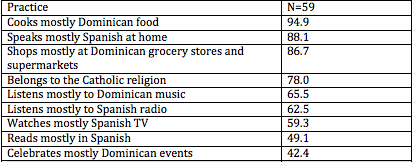From The Peopling of New York City
Please click here
Elsa Chaney argues, “Caribbean life in New York City is the product of the continuous movements of people, cash, material goods, culture and lifestyles, and ideas to and from New York City.”[1]
Contents |
Component of Assimilation
Like any other immigrants, the identity as Dominican, Dominican-American, and American depend on varieties of things. First of all, the length of residence in both countries affects a lot. 1st generation vs. 2nd generation shows that the person’s age when they live in either of two countries is important as well. The book, How the Garcia Girls Lost Their Accents by Julia Alvarez, shows this clearly by showing and let the readers compare sisters of a family who are 1st, 1.5th, and 2nd generation. Also they see the political advantages they can obtain by considering themselves as Dominican, Dominican-American, or American. Milagros Ricourt categorizes Dominican immigrants into three main bodies in her book Dominicans in New York City. New immigrants consider themselves as Dominicans and are more loyal to their mother country. They are normally immigrants who lived in America under 5 years. Dominican-Americans acknowledge that they are part of New York City community. Dominican Americans are ones that were born and/or raised in America. They know their roots, but they feel comfortable with the culture they grew up in. Interesting thing about Dominican immigration is that it is still on going process thus this mixture of identification continues to exist with the growing population. Estimated number of foreign-born Dominicans in NYC is 331,700 as of 2000 according to the data from NYC website. Also a lot of Dominicans go back and forth between DR and the U.S. thus create deeper sense of dual identity by being exposed to both cultures simultaneously. The gender definitely affects assimilation as well. Culturally the U.S. and Dominican Republic have different gender role, and women in the U.S. have more opportunity legally. Cultural preference of individuals and their surroundings determines the great portion of rate of assimilation.
Transnational Identity
Dominicans can be described as a transnational community. A constant flow of people in both directions helps to keep the cultural root. On the other hand, this causes a dual sense of identity. This ambivalent attachment to two countries often confuse them and stress them out. This can cause health problems. This can be seen from characters in literature such as How the Garcia Girls Lost Their Accents by Julia Alvarez. Middle two sisters of four becomes mentally sick in the story. It is because the 1.5th generation of immigrants is the most transnational generation. They feel the sense of belonging from neither countries. From their study in Washington Heights Jorge Duany found out that most of the Dominican immigrants he interviewed – 26 out of 37 – have not yet become U.S. citizens. The study revealed that it was mostly due to short period of time in the U.S. or the lack of English skill, but even the one who has lived and is familiar with English said, “I’m not interested,” ”I feel Dominican.” Those who became U.S. citizen gave only the practical reasons.[2]
| Dominican Republic | 194 | 57.2% |
| USA | 100 | 29.5% |
| Other Countries | 45 | 13.3% |
Second Generation - Dominican American
The second generation Dominicans are establishing a distinguished culture from Dominicans and other Hispanic second generation in many ways. According to Ana Yolanda Ramos from Columbia University, the Dominican teenagers tend to stay away from other lower-class Hispanic teenagers. They still follow the trend of mixing up English and Spanish. Many Dominican teenagers use “Spanglish,” or code switching between Spanish and English, as their primary mode of communication.[3]
References
- ↑ Jorge Duany Quisqueya on the Hudson: The transnational Identity of Dominicans in Washington Heights 2nd Edition CCNY:Dominican Studies Institute
- ↑ Jorge Duany Quisqueya on the Hudson: The transnational Identity of Dominicans in Washington Heights 2nd Edition CCNY:Dominican Studies Institute
- ↑ Jorge Duany Quisqueya on the Hudson: The transnational Identity of Dominicans in Washington Heights 2nd Edition CCNY:Dominican Studies Institute
- Return to Assimilation
- Return to Dominicans
